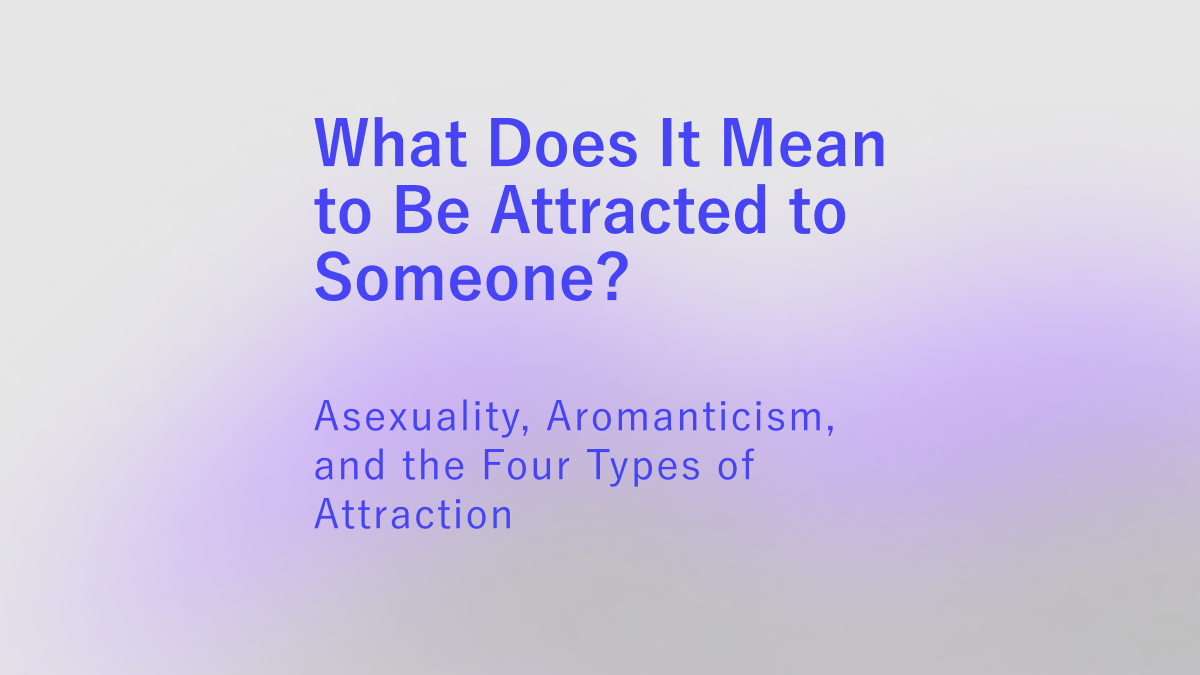What Does It Mean to Be Attracted to Someone? Asexuality, Aromanticism, and the Four Types of Attraction

Did you know that there are many different types of feelings associated with “liking” someone?
For example, wanting to spend time with someone as a friend, wanting a special relationship as a romantic partner, or simply admiring someone’s beauty—these are all ways people can feel “attracted” to others. However, each of these feelings is actually different.
For many people who identify as asexual or aromantic, understanding these differences can be very important. Not experiencing romantic attraction does not mean never feeling attracted to anyone at all—there are various types of attraction.
In this article, we will explore four types of attraction in detail: sensory, romantic, sexual, and aesthetic.
What Are the Four Types of Attraction?
Within the asexual community, the idea of dividing attraction into four categories* became widespread due to “the need for more precise ways to describe personal experiences.”
Even among asexual people, there are many differences in how they experience attraction:
- Some feel romantic emotions, while others do not.
- Some do not experience sexual attraction but enjoy physical affection.
- Some find certain people aesthetically attractive, but that feeling is unrelated to romance or sexuality.
So, what exactly are the four types of attraction? Let’s take a closer look.
1. Sensual Attraction
Sensual attraction is the feeling of wanting physical contact with someone.
This can include wanting to hold hands, hug, or stroke someone’s hair. However, the key point is that these actions do not necessarily have a sexual meaning.
Some asexual people do not experience sexual attraction but do feel sensual attraction. For example, a person might not be interested in romantic relationships but still enjoy hugging close friends.
On the other hand, some people rarely or never feel sensual attraction. They may have no interest in physical contact or feel uncomfortable with it. This, too, is a valid and natural personal difference.
2. Romantic Attraction
Romantic attraction is the feeling of wanting to be in a romantic relationship with someone.
In everyday conversation, the word “like” is often used with a romantic meaning. However, aromantic people may not experience romantic attraction or feel it less strongly. Some may say, “I can’t tell the difference between friendship and romance,” or “The idea of dating doesn’t really make sense to me.”
At the same time, aromantic people can still experience sensual attraction. For example, someone might not want a romantic relationship but still enjoy physical affection like hugging.
3. Sexual Attraction
Sexual attraction is the feeling of wanting to have a sexual relationship with someone.
It is often confused with romantic attraction, but romantic feelings and sexual desire do not always match. For example, some people feel sexually attracted to others but do not experience romantic feelings (some aromantic individuals), while others feel romantic attraction but have no sexual desire (some asexual individuals).
Sexual attraction is also frequently mistaken for sensual attraction, but as mentioned earlier, sensual attraction refers to a preference for physical touch without necessarily having a sexual meaning.
Many asexual people do not experience sexual attraction. However, views on sexual activity vary even among asexual individuals. Some feel comfortable with sex itself and may engage in it if a partner desires, while others do not want any sexual contact at all.
4. Aesthetic Attraction
Aesthetic attraction is the feeling of being drawn to someone’s appearance, thinking “This person is wonderful” or “They look beautiful.”
For example, have you ever thought, “This actor is really gorgeous,” but without feeling romantic attraction or sexual desire?
Asexual and aromantic individuals can also experience aesthetic attraction. Feeling that someone is beautiful and having romantic or sexual feelings for them are different experiences. Just because a person feels aesthetic attraction does not necessarily mean they also feel romantic or sexual attraction.
Attraction from an Asexual and Aromantic Perspective
As we have seen, asexual and aromantic individuals can still experience feeling “attracted” to others. However, this does not necessarily lead to romantic or sexual relationships.
Not experiencing romantic attraction does not mean never feeling drawn to anyone at all—the types of attraction a person experiences vary. For example:
- Aromantic but experiences sensual attraction → Values physical affection in friendships.
- Asexual but experiences romantic attraction → Desires romantic relationships but has no interest in sexual ones.
- Rarely experiences any type of attraction → May have different perspectives on relationships altogether.
Understanding these differences can help asexual and aromantic individuals better express their experiences. It also encourages society to reconsider norms that label their feelings as “wrong” or “lacking something.”
Attraction comes in many forms, and asexual and aromantic individuals may experience different types in their own way. Since each person’s experience is unique, all forms of attraction deserve respect.
We hope that as this idea spreads in society, it will provide a hint for better understanding of both our own feelings and those of others.
*In addition to the four types of attraction discussed in this article, some people also include emotional attraction and intellectual attraction in their analyses.
References:
https://lgbtq.unc.edu/resources/exploring-identities/asexuality-attraction-and-romantic-orientation/
https://www.asexuality.org/?q=overview.html
(Translation: Jennifer Martin)
